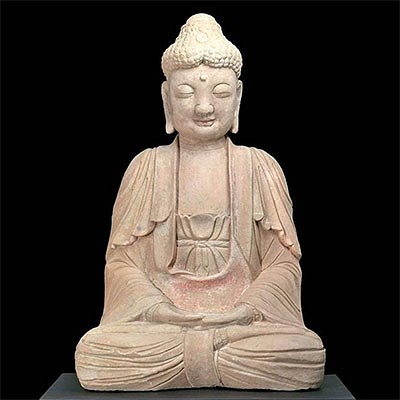Roman Stone Mosaic - Menorah, Shofar & Lulav
Lot 37a
About Seller
Artemis Fine Arts
686 S Taylor Ave, Ste 106
Louisville, CO 80027
United States
Selling antiquities, ancient and ethnographic art online since 1993, Artemis Gallery specializes in Classical Antiquities (Egyptian, Greek, Roman, Near Eastern), Asian, Pre-Columbian, African / Tribal / Oceanographic art. Our extensive inventory includes pottery, stone, metal, wood, glass and textil...Read more
Categories
Estimate:
$4,000 - $6,000
Absentee vs Live bid
Two ways to bid:
- Leave a max absentee bid and the platform will bid on your behalf up to your maximum bid during the live auction.
- Bid live during the auction and your bids will be submitted real-time to the auctioneer.
Bid Increments
| Price | Bid Increment |
|---|---|
| $0 | $25 |
| $300 | $50 |
| $1,000 | $100 |
| $2,000 | $250 |
| $5,000 | $500 |
| $10,000 | $1,000 |
| $20,000 | $2,500 |
| $50,000 | $5,000 |
| $100,000 | $10,000 |
| $200,000 | $20,000 |
About Auction
By Artemis Fine Arts
Feb 18, 2021
Set Reminder
2021-02-18 10:00:00
2021-02-18 10:00:00
America/New_York
Bidsquare
Bidsquare : Exceptional Antiquities, Asian, Ethnographic
https://www.bidsquare.com/auctions/artemis-gallery/exceptional-antiquities-asian-ethnographic-6373
Museum-worthy examples of Egyptian, Greek, Roman, Etruscan, Near Eastern, Far East / Asian, Pre-Columbian, African / Tribal, Oceanic, Native American, Spanish Colonial, Russian, Fossils, Ancient Jewelry, Fine Art, so much more! Artemis Fine Arts info@artemisgallery.com
Museum-worthy examples of Egyptian, Greek, Roman, Etruscan, Near Eastern, Far East / Asian, Pre-Columbian, African / Tribal, Oceanic, Native American, Spanish Colonial, Russian, Fossils, Ancient Jewelry, Fine Art, so much more! Artemis Fine Arts info@artemisgallery.com
- Lot Description
Late Roman, ca. 6th century CE. A special mosaic depicting a seven-lamp (six branches plus the central one) menorah flanked by a lulav and a shofar, delineated with hundreds of square and rectangular stone tesserae of black, grey, and white hues. The menorah was historically used by Moses in the sanctuary he established in the wilderness and later in the famous Temple of Jerusalem. A nine-lamp variation of the menorah is traditionally used for the observance of Chanukah (also Chanuka, Hanukah, Hanukkah, and Hanuka). A lulav is a frond of a date palm tree used during the Jewish holiday of Sukkot, and a shofar is a ram's horn trumpet used by the ancient Jewish people during religious ceremonies and battles, and still played today during the High Holy Days of Rosh Hashanah and Yom Kippur. An outstanding stone mosaic, replete with impressive artistry and technique, featuring three important symbols of Judaism that originated in ancient times. Size: 20" W x 19.625" H (50.8 cm x 49.8 cm); 21.875" W x 21.2" H (55.6 cm x 53.8 cm) with frame
The Brooklyn Museum hosted an exhibition entitled, "Tree of Paradise: Jewish Mosaics from the Roman Empire" (September 16, 2005 to July 16, 2006) that included a mosaic floor from the synagogue of Hammam Lif, Tunisia which was discovered by French army captain Ernest de Prudhomme in 1883. Since then, archaeologists have identified approximately 300 other synagogues in the Mediterranean dating between 300 and 600 CE. Two mosaics depicting seven-lamp menorahs (accession numbers 05.26 and 05.27) like this example, both dating to the 6th century, were included in this exhibition.
Provenance: ex-Phoenicia Holyland Antiquities, New York, New York, USA, acquired 1970s to 2000s
All items legal to buy/sell under U.S. Statute covering cultural patrimony Code 2600, CHAPTER 14, and are guaranteed to be as described or your money back.
A Certificate of Authenticity will accompany all winning bids.
We ship worldwide and handle all shipping in-house for your convenience.
#162593Mounted on a concrete backing and framed. Losses to a few tesserae commensurate with age, with chips and abrasions to other tesserae in scattered areas and light encrustations. Otherwise, a gorgeous example with nice preservation of highly symbolic motifs.Condition
- Shipping Info
-
All shipping is handled in-house for your convenience. Your invoice from Artemis Gallery will include shipping calculation instructions. If in doubt, please inquire BEFORE bidding for estimated shipping costs for individual items.
-
- Buyer's Premium



 EUR
EUR CAD
CAD AUD
AUD GBP
GBP MXN
MXN HKD
HKD CNY
CNY MYR
MYR SEK
SEK SGD
SGD CHF
CHF THB
THB
















